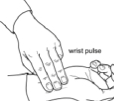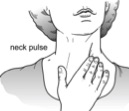Your heart is a muscle that pumps blood throughout your body. Your pulse is your heart rate, or the number of times your heart beats in one minute. This varies from person to person, and it might also vary throughout the day. Your pulse is lower when you are at rest, and it increases when you exercise.
How do I take a pulse?
- Place the tips of your index, second, and third fingers (do NOT use your thumb) on the palm side of your other wrist, below the base of the thumb. Or, place the tips of your index and second fingers on your lower neck, on one side of your windpipe.
- Press lightly with your fingers until you feel a pulsing beneath your fingers. This pulse is the blood moving inside the vessels beneath your skin. You might need to move your fingers around slightly up or down until you feel the pulsing.
- Use a watch with a second hand or look at a clock with a second hand.
- Count the beats you feel for 15 seconds. Multiply this number by four to get your heart rate (pulse). See calculation below.


What is a resting heart rate?
_____________ x 4 = _____________
(number of beats in 15 seconds) (your pulse/resting heart rate)
What is a Typical Pulse?
| Age Group | Normal Heart Rate at Rest |
| Children (ages 3-4 years) | 70 - 100 beats per minute |
| Children (ages 5-7 years) | 65 - 100 beats per minute |
| Children (ages 8-15 years) | 60 - 100 beats per minute |
| Adults (ages 16-18+ years) | 60 - 100 beats per minute |
What is the targeted heart rate?
You gain the most benefits and lessen the risks when you exercise in your target heart rate zone. The Karvonen formula is used to calculate your target heart rate. The return to activity protocol has specific target heart rate zones for each stage that must be monitored and followed.
Your health care provider will determine your return to activity target heart rates depending on your age and resting heart rate.
| Patient name: |
| My resting heart rate is: |
| My target heart rates for my return to activity protocol: Stage I (HR 30-40%) = |
| State II (HR 40-60%) = |
| Stage III (HR 60-80%) = |
| Stage IV (HR 80-90%) = |
This information is for educational purposes only. It is not intended to replace the advice of your health care providers. If you have any questions, talk with your doctor or others on your health care team.
If you are a Gillette patient with urgent questions or concerns, please contact Telehealth Nursing at 651-229-3890.
 Home Page
Home Page
